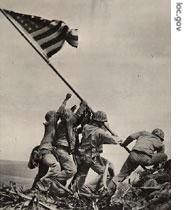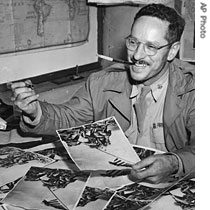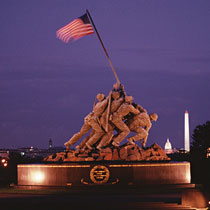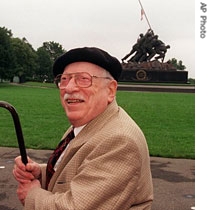VOA慢速英语 2008 0526b
时间:2018-12-15 作者:英语课 分类:VOA慢速英语2008年(五)月
THIS IS AMERICA - Six Men, a World War, a Pacific Island, and an Image for All Time
The story of the flag raising captured in 1945 on Iwo Jima by Associated Press photographer Joe Rosenthal, and the memorial statue it led to. Transcript 1 of radio broadcast:
25 May 2008
VOICE ONE:
Welcome to THIS IS AMERICA in VOA Special English. I'm Steve Ember with Faith Lapidus.
This Monday is Memorial Day in the United States. The holiday honors the memory of the nation's military dead.
VOICE TWO:
One way to preserve a memory is with a camera. This week on our program, we tell the story of a famous photograph from World War Two. It led the sculptor 2 Felix de Weldon to create one of the largest free-standing bronze statues in the world.
(MUSIC)
VOICE ONE:

Joe Rosenthal's Pulitzer Prize-winning photograph taken on the Pacific island of Iwo Jima is one of the best-known war images
Our story is about one moment in time. Really, one-four-hundredth of a second. That is the amount of time it took Associated Press photographer Joe Rosenthal to capture a historic 4 image on film.
The photograph shows six men and an American flag during a battle in World War Two. Joe Rosenthal took it on February twenty-third, nineteen forty-five, on the Pacific island of Iwo Jima. Japanese forces held the island. American Marines were trying to capture it.
On the fourth day of battle, Marines fought to the top of Mount 3 Suribachi, the tallest mountain on Iwo Jima. A small American flag was sent to the top. The Marines placed the flagpole in the ground.
VOICE TWO:
But the small flag could not be seen clearly far below. Commanding officers ordered the Marines to replace it with a much larger one. Joe Rosenthal wanted to make a picture of the event. So he took his camera and began to climb slowly up the mountain.
When he reached the top, Marines were tying the larger flag to a heavy pole. Joe Rosenthal backed away from the group and began talking to another photographer.
A minute later, he saw movement out of the corner of his eye. “There it goes!” he said. He swung his camera up, following the movement of the flag, and pressed the button that took the picture.
VOICE ONE:
Six men are in the photograph. But only four of them are clearly seen.
In the front is Harlon Block, a Marine 5 from Yorktown, Texas. Next is John Bradley. His face is the only one in the picture. He was a Navy corpsman; his job was to treat the wounded.
Also in the picture is Franklin Sousley, a Marine from Hilltop, Kentucky. And all the way at the left is Ira Hayes, a Marine, and an American Indian. The heavy pole holding the flag had just left his hand when the picture was taken.
Behind these four men are two other Marines. They cannot be seen as clearly. They are Rene Gagnon of Manchester, New Hampshire, and Mike Strank. He lived in Johnstown, Pennsylvania, but was born in Jarabenia, in what was then Czechoslovakia.
VOICE TWO:
The next day, Joe Rosenthal’s film went by airplane to the island of Guam where it was developed and printed.
The pictures were given to Associated Press photo editor John Bodkin. It was his job to decide which ones to send to the United States. They would go on a machine that sent images by radio.
As histories tell it, he looked and looked at the first photograph, and said: “This is one for all time.” Within minutes he sent the picture of the six men raising the flag to the Associated Press headquarters in New York.
From there, the photograph went to newspapers across the United States. Most decided 7 to print a huge copy on their front page.
VOICE ONE:

Associated Press Photographer Joe Rosenthal
Most photo experts will tell you that the picture Joe Rosenthal made is almost perfect. The camera catches the flag as it rises. The flagpole cuts across the photograph. Winds blow against the flag.
The experts also say you must look at the picture as the American public saw it in nineteen forty-five. The world had been at war for years. Victory was not yet certain. Many people worried about family members. Many had a deep fear of the enemy.
The picture shows strength and courage. It suggests that six young men are working together to defeat the enemy. Joe Rosenthal’s photograph seemed to say: the battle may not be over, but we are winning.
It was the very image of a future American victory.
(MUSIC)
VOICE TWO:
In Washington, D.C., Felix de Weldon saw the photograph in the newspapers. Born in Austria, he came to the United States and was an artist in the Navy.
Many years later he would say, “I had been an artist all my life. When I first saw it I recognized the power of this photograph. I could not take my eyes from it. I looked at the photograph for some hours and then began working.”
Seventy-two hours later, Felix de Weldon had made a small statue of Joe Rosethal’s picture. Within days, members of Congress had seen the small statue. Many began to call for a huge statue. President Franklin Roosevelt ordered the Marine Corps 6 to send home the men who had raised the flag.
VOICE ONE:
By then, however, it was too late. Mike Strank, Harlon Block and Franklin Sousley were dead. They were among the more than six-thousand Marines killed on Iwo Jima.
Navy Corpsman John Bradley had been severely 8 wounded. But he, Rene Gagnon and Ira Hayes returned to the United States.
People said they were heroes. The three men said they had done nothing but help put up a flag. But Joe Rosenthal’s photograph was so powerful, nothing would change people's minds.
Felix de Weldon soon made a life-size copy of the statue. He carefully copied the faces of the three survivors 9. He used all the photographs he could find for the three who had been killed.
His statue helped pay for America’s war effort. The statue and the three survivors traveled from city to city to raise money.
(MUSIC)
VOICE TWO:
Joe Rosenthal’s photograph became more and more famous. His work earned the Pulitzer Prize.
There was public demand to put the image on a postal 10 stamp. In July of nineteen forty-five, the government agreed. More than one-hundred-thirty-seven-million were printed.
People also demanded a huge statue of the six Marines.
In nineteen forty-six, Felix de Weldon started all over again. First he made a statue out of plaster 11. Then he used the plaster form as a guide to make the final statue out of bronze metal.
Again, he called on the three survivors. Felix de Weldon wanted to make sure he had them correct.
VOICE ONE:

The Marine Corps War Memorial has become known as the Iwo Jima statue in Arlington, Virginia
It took Felix de Weldon nine years to complete the statue. The memorial honors all members of the United States Marine Corps who died in battle since the American Revolution.
On November tenth, nineteen fifty-four, President Dwight Eisenhower led ceremonies at Arlington National Cemetery 12. The burial grounds are across the Potomac River from Washington.
Ira Hayes, Rene Gagnon and John Bradley attended the ceremonies. It was their last time together. Ira Hayes died three months later.
(MUSIC)
VOICE TWO:
Millions of people have come to see the statue that Felix de Weldon made. It stands in a grassy 13 area along a busy road at the edge of Arlington National Cemetery, in Virginia. The statue weighs more than twenty-tons.
Each man is almost ten meters tall. They seem about to move. Their bodies push forward as they struggle to raise the flag. Their clothes show the bones and muscles underneath 14. Their faces show the hard work.

Joe Rosenthal died in 2006. He was 94.
Many visitors say it is an emotional experience. People stand and look up at the six men. And, they take pictures, just as Joe Rosenthal did on February twenty-third, nineteen forty-five.
(MUSIC)
VOICE ONE:
John Bradley was the last to die of the six men who raised the flag on Iwo Jima that day. He died in nineteen ninety-four. Felix de Weldon died in two thousand three. And Joe Rosenthal died in two thousand six.
Soon after the photograph from Mount Suribachi was published, some people began to dispute it. They suggested that Joe Rosenthal had placed everyone where he wanted them, and then took the photo. Joe Rosenthal always said that was not true.
Experts in photography say it is easy to tell that the photo was not posed 15. They say no photographer would make a picture that hides almost all of the people’s faces. And they say no photographer would have two of the people nearly hidden.
You can decide for yourself. A copy of Joe Rosenthal’s photograph, and a picture of Felix de Weldon’s statue, can be found at voaspecialenglish.com.
(MUSIC)
VOICE TWO:
Our program was written and produced by Paul Thompson. I’m Faith Lapidus.
VOICE ONE:
And I’m Steve Ember. Archives of our programs, with transcripts 16 and MP3s, are at voaspecialenglish.com. We hope you can join us again next week for THIS IS AMERICA in VOA Special English.
- A transcript of the tapes was presented as evidence in court.一份录音带的文字本作为证据被呈交法庭。
- They wouldn't let me have a transcript of the interview.他们拒绝给我一份采访的文字整理稿。
- A sculptor forms her material.雕塑家把材料塑造成雕塑品。
- The sculptor rounded the clay into a sphere.那位雕塑家把黏土做成了一个球状。
- Their debts continued to mount up.他们的债务不断增加。
- She is the first woman who steps on the top of Mount Jolmo Lungma.她是第一个登上珠穆朗玛峰的女人。
- This is a historic occasion.这是具有重大历史意义的时刻。
- We are living in a great historic era.我们正处在一个伟大的历史时代。
- Marine creatures are those which live in the sea. 海洋生物是生存在海里的生物。
- When the war broke out,he volunteered for the Marine Corps.战争爆发时,他自愿参加了海军陆战队。
- The medical corps were cited for bravery in combat.医疗队由于在战场上的英勇表现而受嘉奖。
- When the war broke out,he volunteered for the Marine Corps.战争爆发时,他自愿参加了海军陆战队。
- This gave them a decided advantage over their opponents.这使他们比对手具有明显的优势。
- There is a decided difference between British and Chinese way of greeting.英国人和中国人打招呼的方式有很明显的区别。
- He was severely criticized and removed from his post.他受到了严厉的批评并且被撤了职。
- He is severely put down for his careless work.他因工作上的粗心大意而受到了严厉的批评。
- The survivors were adrift in a lifeboat for six days. 幸存者在救生艇上漂流了六天。
- survivors clinging to a raft 紧紧抓住救生筏的幸存者
- A postal network now covers the whole country.邮路遍及全国。
- Remember to use postal code.勿忘使用邮政编码。
- He mixed up some plaster to repair the wall.他和了一些灰泥去补墙。
- She applied the plaster on his shoulder.她将膏药贴在他的膀子上。
- He was buried in the cemetery.他被葬在公墓。
- His remains were interred in the cemetery.他的遗体葬在墓地。
- They sat and had their lunch on a grassy hillside.他们坐在长满草的山坡上吃午饭。
- Cattle move freely across the grassy plain.牛群自由自在地走过草原。
- Working underneath the car is always a messy job.在汽车底下工作是件脏活。
- She wore a coat with a dress underneath.她穿着一件大衣,里面套着一条连衣裙。
- The players strutted and posed for the cameras. 运动员昂首阔步,摆好姿势让记者拍照。
- After the wedding we all posed for a photograph. 婚礼之后,我们全体排好拍了一张照片。
- Like mRNA, both tRNA and rRNA are transcripts of chromosomal DNA. tRNA及rRNA同mRNA一样,都是染色体DNA的转录产物。 来自辞典例句
- You can't take the transfer students'exam without your transcripts. 没有成绩证明书,你就不能参加转学考试。 来自辞典例句